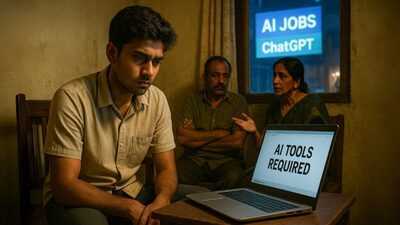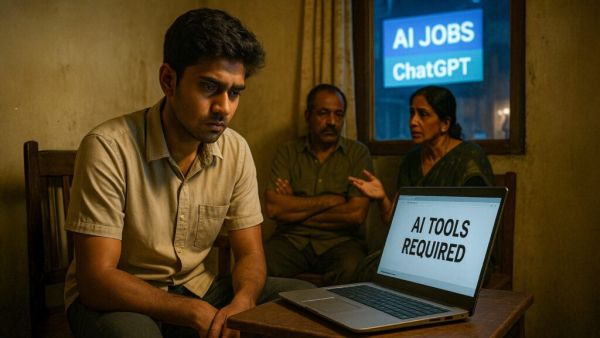

In the India of 2025, everything is changing fast. Metro stations now have AI voice assistants. College students write assignments using ChatGPT. Startup pitch decks are overflowing with “AI-first” strategies. But beneath this digital brightness, a shadow is silently spreading—rarely seen, yet deeply felt in homes across the country.
A young man from a middle-class family—his family’s first graduate—is sitting jobless at home. He’s applying everywhere, but every listing either says “AI tools required” or the role simply doesn’t exist anymore. Someone told him to try freelance writing—but every client says, “We’ll get it done with ChatGPT.” His father doesn’t understand how someone with 75% marks can still be unemployed. His mother suggests, “Do an MBA.” But he already knows: the age of degrees is over, and he has neither the time nor the money.
The fear of AI isn’t limited to coders or engineers. It has reached everyone whose dreams were simple: a clerical job, a teaching post in a private school, or a steady BPO shift. These are the jobs being devoured first by AI. And the new jobs? They look glamorous on LinkedIn — “Prompt Engineer,” “AI Compliance Auditor,” “ML DevOps Lead.” But what these roles require—fluent English, logical reasoning, exposure to global platforms—most Indian youth do not have. Not in their syllabus, not in coaching centers, not in the YouTube algorithms that reach them.
Government reports keep declaring that India has the world’s largest youth population—a so-called “demographic dividend” that echoes in every political speech. But no one explains how this population will survive when most don’t even have access to basic internet. According to NSDC data, only 4.7% of India’s workforce is formally skilled. Each year, 15 million graduates pass out, yet the India Skills Report 2024 says only 45.9% are employable. The rest? They’ve become a crowd filling out online forms, giving mock tests, and slowly vanishing in the digital economy.
AI advocates often say, “New jobs will be created.” That’s true. But let’s be clear—these aren’t jobs that will employ 2,000 people in a factory. These are boutique, specialized roles that only a small, elite group understands. For the masses, there is no space. On one side, automation replaces 100 workers with a single bot; on the other, a startup hires two prompt engineers. How does this equation balance out?
And the most painful truth is this: at the national level, no serious discussion is happening about this crisis. Government skilling programs do exist—Skill India, FutureSkills Prime, NPTEL. But adoption on the ground is so low that even today, in many villages, people still believe “learning computers” means knowing MS Word and Excel.
This piece is not a tech-phobic rant. It is not anti-AI. It is a call for realism. We are not afraid of technology—we are only afraid of being left behind without being told the truth. Data shouldn’t just be reserved for investor decks; it must reflect in government policy.
For India’s youth, the issue isn’t just employment—it’s about dignity and identity. When an educated young man walks into the job market carrying the hopes of his family, and AI renders him invisible, it isn’t just a job that is lost — it’s a dream.
It’s time for the government, the private sector, and the media to come together and make this silent crisis a national headline. Alongside job loss, we need mass skilling, vernacular AI education, and local mentorship ecosystems. Otherwise, AI will not be a rise for India — it will be an extinction event.
The post AI and the Indian Youth: A Story of an Approaching Crisis appeared first on CliQ INDIA.